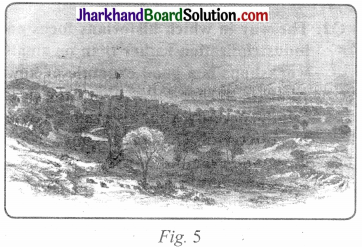JAC Board Class 7th Social Science Solutions Geography Chapter 9 Life in the Deserts
JAC Class 7th Geography Life in the Deserts InText Questions and Answers
Page 69
Question 1.
Can you name some more passes in the Himalayas?
Answer:
Banihal Pass, Burzil Pass, Aghil Pass, etc., are the passes in Himalayas.
JAC Class 7th Geography Life in the Deserts Textbook Questions and Answers
Question 1.
Answer the following questions.
(a) What are the two types of deserts found in the world?
Answer:
The two types of deserts found in the world are the hot deserts and the cold deserts.
(b) In which continent is the Sahara desert located?
Answer:
In Africa, the Sahara desert is located.

(c) What are the climatic conditions of the Ladakh desert?
Answer:
The climatic conditions of the Ladakh desert is exceptionally cold and very dry due to high altitude. In summer, the day temperature are just above zero degree and at night, the temperature are below -30 degree. Most of the time in winters they have the temperatures below -40 degree. The region experiences hot burning sunlight and freezing winds.
(d) What mainly attracts tourists to Ladakh?
Answer:
Treks to the meadows, glaciers and the gompas attract the tourists in Ladakh. In winter, the ceremonies and festivities in which the local people engaged themselves also attract the tourists.
(e) What type of clothes the people of the Sahara desert wear?
Answer:
The types of clothes people in the Sahara desert wear are the heavy robes.
(f) Name the trees that grow in Ladakh.
Answer:
The trees that grow in Ladakh are fruit trees such as apple, apricots and walnuts. Also grown there are scanty patches of shrubs and grasses, groves of willows and poplars.
Tick (√) the correct answer.
Question 2.
(i) Sahara is located in which part of Africa?
(a) Eastern
(b) Northern
(c) Western
Answer:
(b) Northern
(ii) Sahara is what type of desert?
(a) Cold
(b) Hot
(c) Mild
Answer:
(b) Hot

(iii) The Ladakh desert is mainly inhabited by
(a) Christians and Muslims
(b) Buddhists and Muslims
(c) Christians and Buddhists
Answer:
(b) Buddhists and Muslims
(iv) Deserts are characterised by
(a) scanty vegetation
(b) heavy precipitation
(c) low evaporation
Answer:
(a) scanty vegetation
(v) Hemis in the Ladakh is a famous
(a) temple
(b) church
(c) monastery
Answer:
(c) monastery
(vi) Egypt is famous for growing
(a) wheat
(b) maize
(c) cotton
Answer:
(c) cotton
Question 3.
Match the following.
| (i) Oasis | (a) Libya |
| (ii) Bedouins | (b) monastery |
| (iii) Oil | (c) glacier |
| (iv) Gangri | (d) depressions with water |
| (v) Lamayuru | (e) Sahara |
Answer:
| (i) Oasis | (d) depressions with water |
| (ii) Bedouins | (f) Sahara |
| (iii) Oil | (a) Libya |
| (iv) Gangri | (c) glacier |
| (v) Lamayuru | (b) monastery |
Question 4.
Give reasons.
(i) There is scanty vegetation in the . deserts.
Answer:
There is scanty vegetation in the deserts because the climate is either very hot and dry or very cold and dry. Both the conditions are unfavourable for the growth of vegetation. Apart from this, there is less rainfall and lack of sufficient water as well to have vegetation.
(ii) People of the Sahara desert wear heavy robes.
Question
To protect themselves from hot winds and dust storms, the people of the Sahara desert wear heavy robes.

Question 5.
Map skills
(i) On the outline map of Africa, mark the Sahara desert.
Answer:
Do it yourself.
(ii) On the outline map of India, mark the Karakoram Range, Zanskar Range, Ladakh and Zoji La pass.
Answer:
Do it yourself.
(For Fun)
Question 6.
Desert Game This is a class room activity involving all the students. The teacher will create a list of desert creatures. The number of the creatures should be same as the number of students in the class. The creatures can be picked up from the categories of mammals, birds and reptiles.
Mammals can include – camel, yak, fox, sheep, goat, antelope… Birds – raven, eagle, vulture, turkey… Reptiles – snakes … Assign one desert creature to each student. Ask the student to write three characteristics of the creature on plain sheet of paper, (students can use index cards of size 10 cm * 15 cm). Question such as – in what type of deserts it is found? Major adaptation? Use to man?
Answer:
These characteristics will be used as clues in the guessing game. On the board make three columns mammals, birds and reptiles. Paste a sheet of paper in the column under the particular category. The class can be divided in three to four groups. They will compete against each other in the ‘desert game’. Each group now takes turn in guessing the correct answer. Explain to the class that they have to guess what animal matches the characteristics listed on the paper.
For example:
- Animal of hot desert
- Has double set of eyelashes to keep away the sand
- The hide is used for making water bottles.
The correct answer is ‘camel’. Within the group there will be a student who has prepared the card. That student should not answer. Ten points are awarded for the correct answer. This game will enable students to understand the desert You can play the same game by taking different types of fruits, flora and the clothes the people wear.
Answer:
Students need to do this activity in the class.
JAC Class 7th Geography Life in the Deserts Important Questions and Answers
Multiple Choice Questions
Question 1.
All over the world, the Egyptians have been famous for a cash crop that they have been growing since ancient times, which is widely in demand even – today and the cash crop is
(a) Cotton
(b) Maize
(c) Wheat
(d) Barley
Answer:
(a) Cotton

Question 2.
….. are commonly found in Ladakh.
(a) Camels
(b) Churches
(c) Monastries
(d) Buffaloes
Answer:
(c) Monastries
Question 3.
Plants and animals adapt to the exceptionally hot and cold weather conditions and water shortages by adapting themselves by learning skills and developing different techniques which help them survive in the deserts. The are not found in deserts.
(a) Kangaroo rat
(b) Redwood trees
(c) Bactrian camel
(d) Red cactii
Answer:
(b) Redwood trees
Question 4.
Which of the following people do not live in deserts?
(a) Anangus
(b) Tuaregs
(c) Apache Indians
(d) Bedouins
Answer:
(c) Apache Indians
Question 5.
The animals which is not found in Ladakh is/are
(a) The Asiatic Lion
(b) the Himalayan Marmot
(c) the Mountain Sheep
(d) Both (a) and (b)
Answer:
(a) The Asiatic Lion
Question 6.
The common occupation of the people of Ladakh are
(a) cotton farming
(b) tourism
(c) fruit cultivation
(d) Both (b) and (c)
Answer:
(d) Both (b) and (c)
Question 7.
The mineral which is found in Sahara is
(a) copper
(b) iron
(c) zinc
(d) None of these
Answer:
(b) iron

Question 8.
Number of country/ies which touches Sahara desert is/are
(a) 11
(b) 9
(c) 1
(d) 14
Answer:
(a) 11
Question 9.
Vegetation of Sahara desert consists of cactus, palms,
(a) date and apple
(b) fig and date
(c) apple and acacia
(d) date, acacia
Answer:
(a) date and apple
Question 10.
The world’s largest desert is
(a) Sahara desert
(b) Thar desert
(c) Ladakh desert
(d) Kalahari desert
Answer:
(a) Sahara desert
Very Short Answer Type Questions
Question 1.
List the major and famous monasteries of Ladakh.
Question
The major and famous monasteries of Ladakh are Lamayuru, Hemis, Thiksey and Shey.
Question 2.
Name the capital of Ladakh.
Answer:
The capital of Ladakh is Leh.
Question 3.
List the countries which are associated with the discovery of oil.
Answer:
The countries which are associated with the discovery of oil are Egypt, Algeria and Libya.
Question 4.
What is the area of the Sahara desert?
Answer:
The area of the Sahara desert is approximately 8.54 million sq km.
Question 5.
Name the place which recorded the highest temperature of 57.7°C in 1922.
Answer:
A1 Azizia in the Sahara desert which is south of Tripoli, Libya recorded the highest temperature of 57.7°C in 1922.
Question 6.
Which are the four passes that Manali – Leh highway crosses?
Answer:
Manali Leh highway crosses four passes, Rohtang la, Baralacha la Lungalacha la and Tanglang la.

Question 7.
What type of desert are Sahara and Ladakh?
Answer:
The type of desert are:
- Sahara hot desert
- Ladakh cold desert
Question 8.
Which is the most important river that flow through Ladakh?
Answer:
The most important river that flow through Ladakh is Indus.
Question 9.
What do you mean by desert?
Answer:
Desert is an arid region distinguished and marked by extremely high or low temperatures and has scarce vegetation.
Question 1.
Where is Tafilalet Oasis situated and what is the area of this oasis?
Answer:
Tafilalet Oasis is situated in Morocco and is a very large oasis with an area of approximately 13,000 sqkm.
Short Answer Type Questions
Question 1.
How many countries touches the Sahara desert? Name them all.
Answer:
The Sahara desert touches eleven countries which are Algeria, Chad, Egypt, Libya, Mali, Mauritania, Morocco, Niger, Sudan, Tunisia and Western Sahara.
Question 2.
Oasis in the Sahara has settled population. Explain briefly.
Answer:
Oasis in the Sahara has settled population because these areas are fertile and people may settle around these water bodies and grow date palms and other crops.
Question 3.
Nomadic tribes of Sahara desert rear livestock. Why do they do?
Answer:
These animals yields milk, hides from which they make leather for belts, slippers, water bottles; hair is also used for mats, carpets, clothes and blankets hence nomadic tribes of Sahara desert rear livestock.

Question 4.
Briefly describe the changes which are undergoing in the cultural environment of the Sahara desert.
Answer:
The following changes which are undergoing in the cultural environment of the Sahara desert are:
- In the salt trade, trucks are replacing camels.
- Big and huge glass office buildings, towers are shining over mosques. Super highways criss-cross the ancient camel paths.
- Tuaregs are working as guides to the foreign tourists.
- More and more nomadic herdsman are shifting to the city for finding jobs in gas and oil operations.
Question 5.
Describe in brief the climate of the Sahara desert.
Answer:
The climate of the Sahara desert is unbearably hot and parch dry. It has a very short rainy season and the sky is clear and cloudless. The days are extremely hot and the temperature rises upto 50 degrees. The nights are freezing cold nearing zero degree.
Question 6.
In which way Sahara became a desert?
Answer:
Sahara once used to be a lush green plain. In Sahara desert, cave paintings depicts that there were rivers with . crocodiles. Common animals were found such as elephants, lions, giraffes, ostriches, sheep, cattle and goats. Due to the change in climate, it has changed to a very hot and dry region.
Question 7.
Describe in brief the rich fauna of Ladakh.
Answer:
Ladakh is very rich in fauna. Many bird species and animals are seen. In Ladakh, common birds are tibetian snow cock, robins, raven, redstarts and hoopoe. Few of them are migratory. The animals which are found are wild goats, wild sheep, yak and special kinds of dogs.
Question 8.
Describe in brief the activities of the people of Ladakh in summers and winters.
Answer:
There are many activities the people of Ladakh are engaged in summers and winters. People are busy in cultivation work during summers. They grow crops such as potatoes, pear, turnip, barley and beans. During winter, they engage themselves in different festivities and ceremonies as winters are unbearable and harsh.
Women manage both house and field very efficiently. One of the important occupation is weaving. Pashmina shawls are weaved from the wool of the chiru antelope. Carpets and rugs from the sheep. Many popular products such as butter, milk and hides are obtained from yak.

Question 9.
What is the location of Ladakh?
Answer:
Ladakh is a cold desert which is lying in the Great Himalayas on the eastern side of Jammu and Kashmir. In the north, the Karakoram Range and the Zanskar mountains in the south enclose it. Many rivers flow through Ladakh and Indus being the most important amongst them.
Long Answer Type Questions
Question 1.
Distinguish between the deserts of Sahara and Ladakh.
Answer:
Sahara
- Sahara is a hot desert.
- It is located in northern Africa.
- The climate is extremely hot and parched dry.
- It attracts very less tourists.
- They are mainly nomadic tribes. Oasis offers settled population.
- Few plants grow such as cactus, date, palm and acacia.
Ladakh
- Ladakh is a cold desert.
- It is located in northern Himalayas, India
- The climate is extremely cold and dry.
- It attracts tourists because of its festivities and different ceremonies.
- The people are either Muslims or Buddhists.
- Fruits trees grow such as apples, apricots. Trees such as poplar, willows, etc. also grows.
JAC Class 7 Social Science Solutions
![]()
![]()





